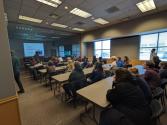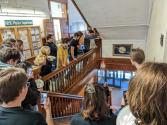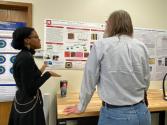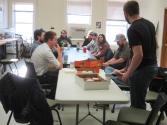SPS Zone Meeting
March 24, 2023 to March 26, 2023
Fargo, ND
Meeting host: By:William Tupa
SPS Chapter:

Report of 2023 SPS Zone 11 Meeting
Agenda
- Friday, March 24, 2023
○ Late-night hot chocolate gathering with students from NDSU and UND
- Saturday, March 25, 2023
○ Breakfast (donuts, bagels, coffee, tea, and juice)
○ Lab tours: NDSU faculty led tours of Research 1 and 2 buildings, including Physics labs, Coatings & Polymeric Materials labs, and high-performance computing center (CCAST)
○ Lunch in the Department of Physics (sandwiches from Jimmy John’s)
○ Research seminar: Dr. Wayne Barkhouse, Professor of Physics and Astronomy, UND, gave a talk on “Specific Frequency of Globular Clusters Problem”
○ Poster session: SPS members presented posters and shared their research with other members and with NDSU faculty
○ Dinner in the Department of Physics (pizza from Papa John’s)
○ Mixer: gathered at Herd & Horns (restaurant next to NDSU) to chat and get to know each other more
- Sunday, March 26, 2023
○ Breakfast (donuts, bagels, coffee, tea, and juice)
○ Egg drop competition: groups (one student from each school) were allotted 30 minutes to build a contraption to protect an egg when dropped out of a window
○ Business meeting: discussed annual reports, starting a Sigma Pi Sigma chapter, chapter funding (e.g., outreach events, departmental support, student government) and possibly meeting up at the 2024 APS March Meeting in Minneapolis, MN
○ Closing remarks and thank you’s
Chapters and Attendees
The meeting was hosted by the NDSU Chapter and Department of Physics and was attended by a total of 31 SPS members from NDSU, University of North Dakota, Minnesota State University Moorhead, South Dakota School of Mines, and University of Nebraska - Lincoln.
Future Recommendations
It was brought up that activities (such as the egg drop) should be included on the first day of the meeting to help break things up and introduce everyone. We think that less time should be given for the egg drop as it became too easy for everyone to build their contraptions. It would also be a good idea to test the egg drop beforehand, as the heights we planned to use turned out to not be high enough and too many eggs survived.
For the poster session, we think it would be good to encourage more students to present. Earlier planning of the Zone Meeting with other Chapters would also give people more time to prepare a poster, in case they didn’t already have one made.
Narrative
SPS chapters from Zone 11 assembled at North Dakota State University for this year’s Zone Meeting. Chapters from University of North Dakota, Minnesota State University Moorhead, South Dakota School of Mines, and University of Nebraska - Lincoln attended, bringing a total of 31 enthusiastic physics undergraduates together for a weekend in Fargo, ND. The meeting occurred from March 24th to March 26th, 2023. During this exciting weekend, everyone got to make new connections, share their research, and have plenty of laughs along the way.
The meeting kicked off Friday night with a hot chocolate gathering for chapters arriving early. Students from University of North Dakota in Grand Forks, ND joined first and told us about the cloud chambers they had constructed as a project for their chapter using materials from smoke detectors. NDSU and UND students shared their challenges with revitalizing their chapters after COVID and discussed how to encourage new students to get involved.
Saturday morning came quickly and the meeting reached full attendance. Students from South Dakota and Nebraska braved the cold weather of North Dakota and were rewarded with coffee and donuts! NDSU’s SPS faculty advisor, Dr. Alan Denton, assisted with planning, logistics, and food service. After getting to know each other more and meeting everyone, a caravan of physics students drove to NDSU’s Research 1 building (R1) to tour research labs and the supercomputer cluster. These tours were led by Dr. Andrew Croll of the Physics Department, Dr. Khang Hoang and Nick Dusek of CCAST (Center for Computationally Assisted Science and Technology), and Dr. Mohi Quadir and Dr. Xiaoning Qi of the Coatings and Polymeric Materials Department.
Within the Physics lab at R1, Dr. Croll explained his current research, as well as the research of his colleagues, Dr. Yongki Choi and Dr. Erik Hobbie. One of Dr. Croll’s research projects is understanding the physics of folding and wrinkling of materials. When a sheet of paper is folded once and then folded again in the orthogonal direction, the stress has been focused to a point of non-zero Gaussian curvature. Dr. Croll’s group explores what the general rules of this transition might be. During the tour, Dr. Croll introduced us to the research of Dr. Choi’s group on single molecular biology. His group developed a single-molecule technique by integrating a single biomolecule with a carbon-nanotube field effect transistor. With this technique, biochemical events can be watched, recorded, and analyzed in real time. The aim of this research is to probe the unknown molecular mechanisms and functions of enzymes involved in human diseases, including cancer. The tour group also learned about the research of Dr. Hobbie’s group, which focuses on the synthesis, processing, and characterization of colloidal silicon, perovskite, and metal nanocrystals. These nanomaterials can self-assemble and be used in high-performance polymer nanocomposite films for applications in lighting, energy, and biomedical engineering.
Before these tours began, Dr. Hoang gave a presentation on high-performance computing (HPC). This technology allows researchers to use a multitude of CPU cores in parallel, which immensely speeds up the computations. NDSU’s HPC center (CCAST) is housed in the Research 2 building. The nodes run the Linux operating system and distribute computing power among researchers via a job scheduler. CCAST has two clusters: Thunder comprises 3,700 CPU cores and 22 GPU cards. Thunder Prime contains 4,200 CPU cores, as well as 22 GPU cards. These clusters are utilized by researchers in a variety of disciplines, including agriculture, engineering, the sciences, and the arts, to process images, sort data, and run simulations.
The second part of the tour followed with a short walk to R2 and CCAST. We were able to enter the machine room containing the Thunder and Thunder Prime clusters. The first thing we noticed was how loud the room was. Due to the massive energy consumption of the clusters, the room must be cooled using industrial fans and liquid coolant lines running from ceiling to floor. We were able to peak inside the clusters and see the structure of the nodes that perform the necessary calculations for researchers.
The last leg of the tour concluded with the labs of Dr. Qi and Dr. Quadir. Dr. Qi’s group focuses on coatings for materials that prevent corrosion. To stress these coatings, the group subjects materials to shearing and bending, extremely hot temperatures, and applies humid conditions to test performance and strength of the coatings. Dr. Quadir’s group focuses on application-based synthesis of polymers and biomaterials for use in human health, disease prevention, and improving food and water quality.
After the lab tours, we broke for lunch and then had a presentation from Dr. Wayne Barkhouse, Department of Physics and Astronomy, UND, on the “Specific Frequency of Globular Clusters Problem.” Globular clusters are compact spherical clusters of stars. Astronomers have observed several oddities in the frequencies of these clusters and how they appear in different types of galaxies. The breakthrough technology of the James Webb Space Telescope brings a promising future for astronomers with more detailed images and deeper views into our observable universe. This talk was very fun and engaging for everyone and we all learned a lot about astronomical research, a field to which many Physics undergraduates don’t receive much exposure.
Following the talk, we set up research posters that 10 students brought and had an undergraduate poster session. The room was full of energy and exciting discussions of student research on a variety of topics: quantum simulations, analysis of data from particle accelerators, neutrino measurements, methods for detecting exoplanets, and material properties of ferroelectric membranes. After the poster session, we enjoyed pizza and relaxed from a long and exciting day. Later in the evening, many students met at a local restaurant, Herds & Horns, for refreshments and snacks accompanied with casual nonacademic socializing.
On Sunday morning, everyone met again on campus for breakfast and an egg drop competition. We broke into teams of 3-4 people with the goal that everyone on a team was from a different school. Teams were tasked with building a contraption, out of craft materials, that would protect an egg from certain doom as it was dropped. The time allotted was found to be too much as nearly all the eggs survived falls out of a second story window! After the egg drop competition, our Associate Zone Councilor, Serenity Engel, gave a presentation on SPS outreach, Sigma Pi Sigma, and the SPS annual report. Students were also given the chance to share ideas about fun projects and fundraising opportunities.
The meeting concluded on Sunday afternoon, when everyone said goodbye to new friends and connections, with the plan of reconnecting at the 2024 APS March Meeting in Minneapolis, MN. Here at the NDSU SPS chapter, we hope everyone enjoyed attending this meeting as much as we enjoyed planning and hosting it. We met so many great and inspiring students from different states, and are very grateful to them for taking the time and effort to travel to Fargo and visit our campus. We are also grateful for the professors and researchers of NDSU who helped make this meeting possible and to Dr. Wayne Barkhouse for giving a phenomenal astronomy presentation.
Areas of Alignment:



